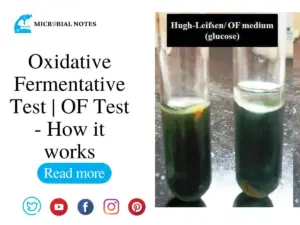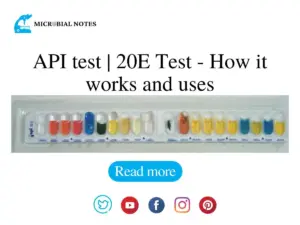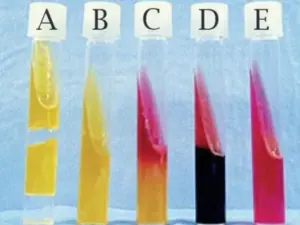Introduction
The bile esculin test is a microbiological assay used to determine the ability of microorganisms to hydrolyze esculin in the presence of bile salts. It is commonly employed for the identification and differentiation of certain bacterial species, particularly within the Enterococcus genus. This test relies on the presence of esculinase, an enzyme produced by bacteria, which breaks down esculin into glucose and esculetin.
Esculin is a luminous glycosidic coumarin derivative (6-beta-glucoside-7-hydroxy-coumarin), and the decrease in the fluorescence indicates the presence of hydrolysis. Through the years, the bile-esculin test has been improved and speeded up. These days, it is possible to quickly distinguish between Group D Streptococci and non-Group D Streptococci using bile-esculin discs.
Purpose
This test is used to distinguish between Enterococci and Group D Streptococci based on their tendency to hydrolyze esculin when bile is present.
Principle of the Bile Esculin Test
The bile esculin test is a microbiological test used to determine the ability of microorganisms to hydrolyze esculin in the presence of bile salts. The test is primarily used for the identification and differentiation of certain bacterial species, particularly within the Enterococcus genus. Esculin, a glycoside, serves as the substrate for the enzymatic reaction. The purpose of this test is to assess the ability of microorganisms to hydrolyze esculin, leading to the production of a specific reaction product.
Components Required for the Test:
To perform the bile esculin test, several components are required. These include:
Bile esculin agar: It is a selective and differential medium that contains esculin as the substrate and bile salts as inhibitors of non-enterococcal organisms. The agar also contains other nutrients necessary for the growth of bacteria.
Test organism: The sample being tested, typically a bacterial isolate, is inoculated onto the bile esculin agar.
Incubator: A temperature-controlled incubator is required to maintain the optimal temperature for bacterial growth and enzymatic reactions.
Chemical Reactions Involved:
The bile esculin test involves two main chemical reactions:
Hydrolysis of Esculin: The test organism possesses the enzyme esculinase, which hydrolyzes esculin into glucose and esculetin. This reaction is catalyzed by the esculinase enzyme, which is produced by certain bacteria, such as Enterococcus species. The hydrolysis of esculin results in the formation of glucose and esculetin.
Reaction with Ferric Citrate: In the presence of ferric citrate, esculetin reacts to form a black or dark brown complex. This reaction is known as the ferric citrate reaction and is used as an indicator of esculin hydrolysis. The darkening of the medium indicates a positive test result.
The hydrolysis of esculin and subsequent reaction with ferric citrate can be summarized as follows:
Esculin + Water (Esculinase) → Glucose + Esculetin
Esculetin + Ferric Citrate → Black or Dark Brown Complex
The production of a black or dark brown color within the bile esculin agar indicates a positive result, suggesting that the test organism has the ability to hydrolyze esculin.
Requirements
Media : esculin agar, bile esculin agar, bile esculin azide agar and broth can be used.
Composition of bile esculin agar:
| Components | Gram/L |
| Peptic digest | 5 |
| Esculin | 1 |
| Beef extract | 3 |
| Ferric citrate | 0.5 |
| Bile salts | 40 |
| agar | 15 |
Apparatus: inoculating needles, test tubes, pipettes, incubator, long wave UV light (360nm), petri plates,
Methods
- Test tube method
- Disc method (rapid method)
Procedure
Test tube method
- With the help of a sterile inoculating needle, a well-isolated colony is extracted from an 24 hour culture.
- Light inoculum selected from the culture plate streaked on the surface of the slant of the bile esculin agar tubes.
- A 10µl calibrated loopful of a 0.5 McFarland standard suspension produced in sterile water is used to inoculate the tubes for the detection of enterococcus and S. bovis.
- To provide sufficient aeration, the test tube caps should be left slightly loosen up.
- The color change is then noticed after the tubes have been incubated aerobically at 35–37°C for 24 hours (or up to 7 days for slow-growing Gram-negative rods and anaerobes).
- The tubes for esculin broth without iron (III) citrate are checked for loss of fluorescence every day.
- Two or three drops of 1.0% ferric ammonium citrate are added to the esculin tube in the absence of fluorescence, and the color change is then observed.
Results
The medium blackening indicates a positive tube test in media containing ferric ammonium citrate.
If there is no color change, the tube test was negative. Under UV light (366 nm), the medium will glow.
When testing esculin broth without iron (III) citrate, a positive result is shown by either the medium losing its fluorescence or the broth turning black after the addition of the ferric [iron(III)] reagent.
If the organism fails to grow in the presence of bile, regardless of the capacity to hydrolyze esculin, a negative test result also occurs in the bile-esculin medium.
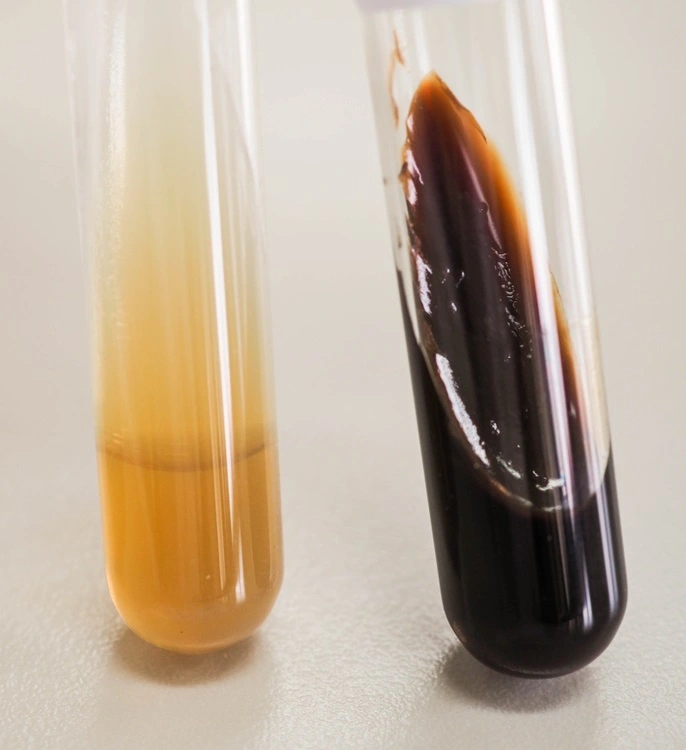
Disc method
- One drop of deionized or distilled water is used to moisten the esculin disc. But the disc shouldn’t be saturated.
- Two to three well-isolated colonies are selected from an overnight (18 to 24-hour) culture using a sterile loop.
- After about 10 minutes at room temperature, the disc is checked to see if a dark brown or black color has developed.
Results
A dark brown or black color that develops throughout the disc test is a sign of positive results.
An uncolored disc test results in a negative result.
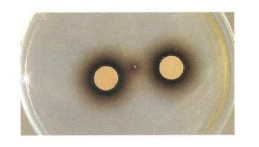
Examples of positive and negative bacteria
| Positive Bacteria | Negative Bacteria |
| Enterococcus faecalis | Streptococcus pyogenes |
| Enterococcus faecium | Streptococcus pneumoniae |
| Enterococcus durans | Staphylococcus aureus |
| Enterococcus hirae | Escherichia coli |
| Enterococcus gallinarum | Salmonella enterica |
Advantages
- A biochemical test called the bile esculin test is used to isolate enterococci and group D streptococci.
- These organisms can be distinguished from Streptococci and other Gram-positive bacteria using this method as well.
- A selective differential medium for the growth of microbes like Enterococci, Listeria, and Yersinia enterocolitica is bile esculin agar.
Limitations
- Streptococci other than S. bovis may produce a positive reaction on bile-esculin agar if an adequate inoculum is used or if the percentage of bile is less than 40%.
- S. bovis cannot be distinguished from other viridans group streptococci using esculin tests without bile.
- The esculin hydrolysis test may generate false-positive results because several organisms can release H2S during metabolism, which can combine with iron to form a black complex.
- Only after a long incubation some microbes, including E. coli, that have -glucosidase produce a positive response in this test. However, if the test is being used to find the activity of – in other organisms, lengthy incubation shouldn’t be carried out.
Quality control
- Use a well-known positive strain, such as ATCC 29212 Enterococcus faecalis. Within 24 to 48 hours, the medium should to turn black.
- Use an Escherichia coli (ATCC 25922) strain that is recognized as being negative. The medium shouldn’t turn black as a result.
- The plates should be incubated aerobically for 24-48 hours at 35-37°C.
- Check the plates for any signs of a blackening of the growth’s media. Blackening indicates POSITIVE result, while no color change indicates an negative result.
- Keep track of the results for every test organism and the controls.
- Repeat the test using new media and cultures if the findings do not match what was anticipated.
- Keep accurate records of all test results and quality control processes carried out.
References
- NAYAK, N., BARAL, N., BAHADUR, N., GOKHALE, S., GOWDA, S., HAMAL, D., BHATTA, D. & RAO, K. J. N. M. C. J. 2018. Listeria meningitis in a three year old immunocompetent child: a case report from a tertiary care hospital in Nepal. 20, 187-190.
- https://www.sigmaaldrich.com/deepweb/assets/sigmaaldrich/product/documents/604/416/80507dat.pdf
- Tille, P. M., & Forbes, B. A. (2014). Bailey & Scott’s diagnostic microbiology (Thirteenth edition.). St. Louis, Missouri: Elsevier.

